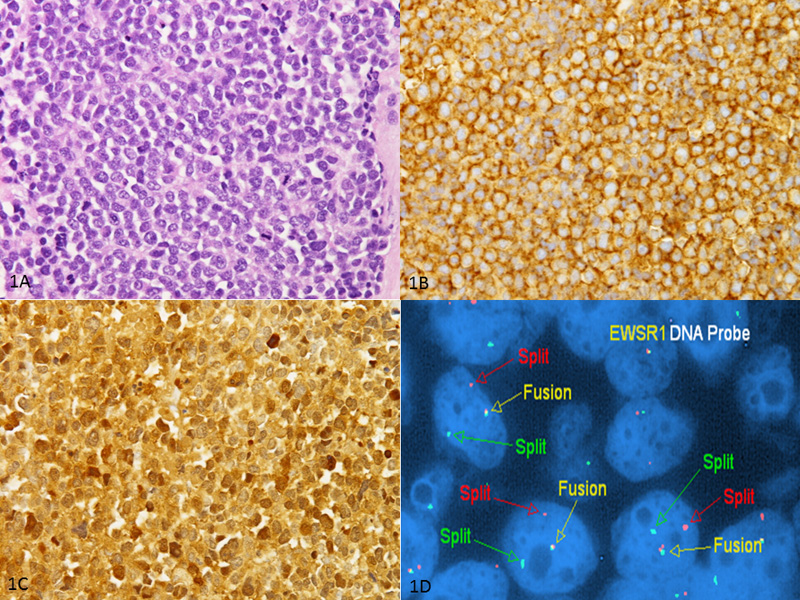
![]() Contributed by Binara Assylbekova, MD and Octavia M. Peck-Palmer, PhD
Contributed by Binara Assylbekova, MD and Octavia M. Peck-Palmer, PhD
INTRODUCTION
Ewing Sarcoma (ES)/Primitive Neuroectodermal Tumors (PNET) rarely present as primary tumors of female genital tract. In gynecologic tract, demonstration of translocation involving Ewing Sarcoma Gene (EWSR1) is considered a gold standard for diagnosis. Here we describe 2 cases of primary uterine PNETs with Fluorescence in Situ Hybridization (FISH) proven EWSR gene rearrangement. To the best of our knowledge there are only 4 previously reported cases of uterine PNET with reverse transcription polymerase chain reaction (RT-PCR) proven EWSR-FLI1 fusion gene product (Sinkre et al, 2000, Katuria et al, 2011).
CASE REPORT
A G2P2, s/p 2 C-sections, presented to emergency department with severe back pain and was found to have lytic lesions in lumbar spine and a pelvic mass. Bone scan revealed diffuse metastatic disease involving ribs, thoracic and lumbar spines, long bones of left lower extremity and skull. Initial endometrial biopsy showed poorly differentiated and necrotic neoplasm. Due to severity of the symptoms patient received palliative radiation therapy. Total abdominal hysterectomy with bilateral salpingo-oophorectomy was also performed for palliative reasons and for establishing a definitive diagnosis.
PATHOLOGIC FINDINGS
A 15.5 x 7.5 x 6.0 cm intramural, variegated, focally fleshy, sponge like mass with hemorrhage and necrosis was seen. Microscopically the tumor showed poorly differentiated small blue cell neoplasm. Tumor cells were positive for NSE and CD99. All other stains including cam 5.2, AE1/AE3, desmin, caldesmon, synaptophysin, chromogranin, S100, LCA, CD10, and EMA were negative. The specimen was submitted for EWSR1 gene rearrangement by FISH, that showed positive rearrangement in 91.6% of cells examined (nuc ish(EWSR1x2)(5'EWSR1 sep 3'EWSR1x1)[185/202]).

CLINICAL FOLLOW UP
Patient underwent another 10 fractions of radiation therapy after surgery. She also had chemotherapy. Unfortunately she died of widespread metastatic disease 3 years later.